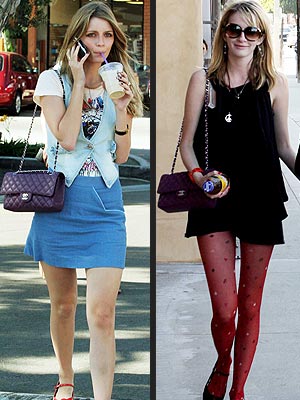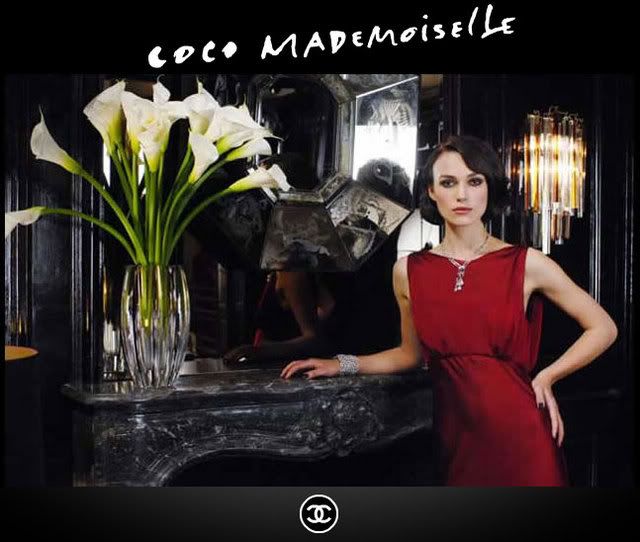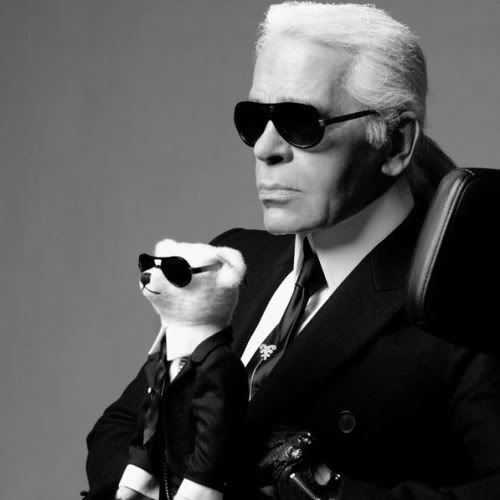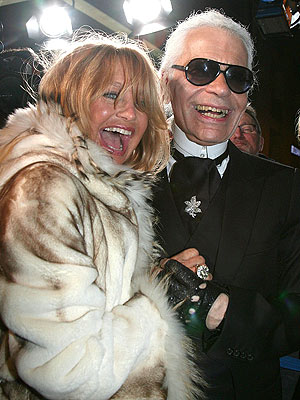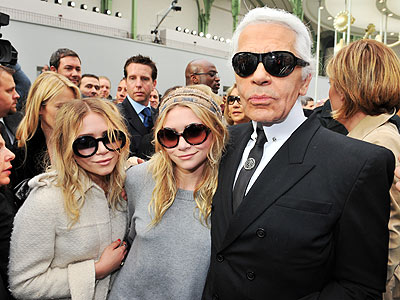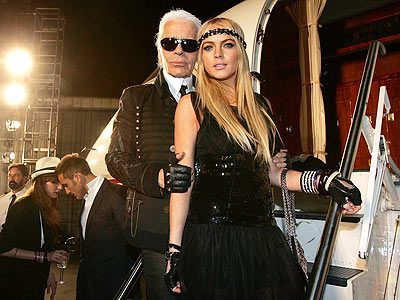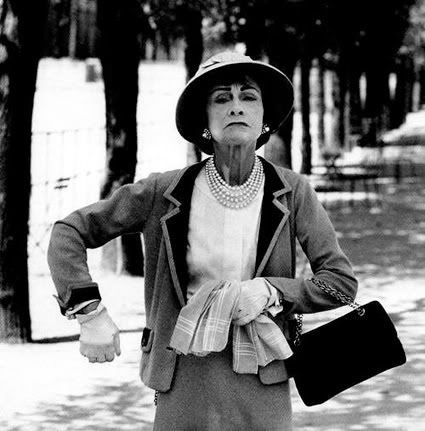
Wednesday 18 February 2009
Monday 16 February 2009
Friday 13 February 2009
Thursday 12 February 2009
Wednesday 11 February 2009
Tuesday 10 February 2009
Wednesday 4 February 2009
2.55: Secrets of a mith
Objects of desire, dream and luxury, the books say a style. especially to become myths, like the inescapable 2:55

It is impossible that never felt a cold front to defoliate in the first pages of fashion at the beginning of the season. Specially to reach the part of accessories, where we see a plethora of it in bags that make your eyes shine. Explain why, no one knows, but the fact is that the purses give us power and individuality. Some more than others, of course. between them, there is specially one that is a heart throb as much as the first female passion. It is 2.55 and it's Chanel.
Established in February 1955, which served as inspiration for its name, 2.55 was created by Coco Chanel and still being an icon of timeless style. Originally made in leather for day and silk for the evening, this accessory can be almost compared to a piece of art. It is needed almost 18 hours, from 6 to 15 persons and more than 180 operations to which this book can get to your central distribution and thus start a round the world, stopping in major capital and giving the opportunity to hundreds of women to engage a dream. Buy it or ... at least admire it.
Like the camellia, the No. 5, the arc of pearls and petite robe noire, 2.55 is also part of the icons of Maison Chanel. Designed to be both practical and aesthetic, the secret of this book lies mainly in two facts: that of having managed to overcome the barrier of time, becoming a classic, and its versatility that transforms into a perfect accessory to combine with some jeans with a tailleur or an evening gown. Today, along with the original model in black leather, thirty new versions are made for each station.
Created in 2006, the Chanel Mobile Art, designed by Karl Lagerled and designed by architect Zaha Hadid, was unavoidable in March this honor in the history of fashion, the ROJECT 2:55 for the future. Inspired by the forms of this suitcase, this flag, rather than an itinerant exhibition, proposes a trip sensasorial at 2:55 through the universe works of two dozen artists who had the sole use of the briefing items that form their identity. An exhibition which went through Hong Kong, Tokyo and New York and might visit in May in London. Undoubtedly a good suggestion for the unconditional or the fans who just want to dream.
Monday 2 February 2009
Chanel n.5

According to one story of the creation of Chanel No. 5, Coco Chanel commissioned the renowned perfumer Ernest Beaux to make six perfumes for her choosing. They were labelled No. 1, No. 2, etc. through No. 6. (Breaux himself, q.v., relates a slightly different version of the story). It was bottle No. 5 that was to Chanel's liking and became the chosen formula. The number "5" was also her lucky number.
At the time of its inception, the most expensive perfume oil was jasmine due to the expensive distilling process. Chanel wanted to create the most costly perfume in the world, and as such No. 5 relies heavily on jasmine.
Chanel introduced it first to some of her friends on May 5, 1921. Initially, it was given to preferred clients for free at her boutique. The fitting rooms in her boutique were also scented with No. 5. This strategy is practiced today by retailer Abercrombie & Fitch with their own signature perfumes and colognes.
In 1924, Pierre Wertheimer partnered Coco Chanel in her perfume business. He owned 70%, Coco owned 10%, and her friend Bader owned 20%. Chanel agreed to owning such a small amount in exchange for having complete control over the product. Today, the Wertheimer family still runs the perfume business.
"I want to give women an artificial perfume," said Chanel. "Yes, I really do mean artificial, like a dress, something that has been made. I don't want any rose or lily of the valley, I want a perfume that is a composition." [4] No. 5 is famous for being the first perfume to heavily rely on synthetic floral aldehydes as a top note. Before synthetics, perfume either had to be applied very heavily or frequently so that the fragrance would last.
"A woman who doesn't wear perfume has no future"
Chanel applied the French aesthetic theory that "ugly" placed next to "beautiful", by contrast, makes the beautiful object appear more so. In this era almost all perfumes were floral and "pretty" - designed to enhance a woman's beauty with more beauty. Instead of the scent of flowers, Coco wanted a perfume that "reflects my personality, something abstract and unique". She thought that a perfume should serve to spotlight a woman's natural beauty using contrast - i.e. the artificial perfume would make the woman's natural beauty more evident.

Chanel No. 5 is classified as a floral-aldehyde. Its top notes include ylang ylang, neroli and aldehydes; its mid notes May rose and jasmine; and its base notes sandalwood, vetiver and vanilla.
In the UK, Chanel No. 5 was originally available in three strengths: Pure Perfume, Eau de Toilette and Eau de Cologne. The Eau de Cologne was discontinued in the 1990s, and an Eau de Parfum introduced.
Sunday 1 February 2009
Coco Chanel
She was shrewd, chic and on the cutting edge. The clothes she created changed the way women looked and how they looked at themselves.
Coco Chanel wasn't just ahead of her time. She was ahead of herself. If one looks at the work of contemporary fashion designers as different from one another as Tom Ford, Helmut Lang, Miuccia Prada, Jil Sander and Donatella Versace, one sees that many of their strategies echo what Chanel once did. The way, 75 years ago, she mixed up the vocabulary of male and female clothes and created fashion that offered the wearer a feeling of hidden luxury rather than ostentation are just two examples of how her taste and sense of style overlap with today's fashion.
Chanel would not have defined herself as a feminist — in fact, she consistently spoke of femininity rather than of feminism — yet her work is unquestionably part of the liberation of women. She threw out a life jacket, as it were, to women not once but twice, during two distinct periods decades apart: the 1920s and the '50s. She not only appropriated styles, fabrics and articles of clothing that were worn by men but also, beginning with how she dressed herself, appropriated sports clothes as part of the language of fashion. One can see how her style evolved out of necessity and defiance. She couldn't afford the fashionable clothes of the period — so she rejected them and made her own, using, say, the sports jackets and ties that were everyday male attire around the racetrack, where she was climbing her first social ladders.
It's not by accident that she became associated with the modern movement that included Diaghilev, Picasso, Stravinsky and Cocteau. Like these artistic protagonists, she was determined to break the old formulas and invent a way of expressing herself. Cocteau once said of her that "she has, by a kind of miracle, worked in fashion according to rules that would seem to have value only for painters, musicians, poets."
By the late '60s, Chanel had become part of what she once rebelled against and hated — the Establishment. But if one looks at documentary footage of her from that period, one can still feel the spit and vinegar of the fiery peasant woman who began her fashion revolution against society by aiming at the head, with hats. Her boyish "flapper" creations were in stark contrast to the Belle Epoque millinery that was in vogue at the time, and about which she asked, "How can a brain function under those things?" Something that Chanel can never be accused of is not using her brain. Her sharp mind is apparent in everything she did, from her savvy use of logos to her deep understanding of the power of personality and packaging, even the importance of being copied. And she was always quotable: "Fashion is not simply a matter of clothes. Fashion is in the air, born upon the wind. One intuits it. It is in the sky and on the road."
It is fitting, somehow, that Chanel was often photographed holding a cigarette or standing in front of her famous Art Deco wall of mirrors. Fashion tends to involve a good dose of smoke and mirrors, so it should come as no surprise that Gabrielle Chanel's version of her life involved a multitude of lies, inventions, cover-ups and revisions. But as Prada said to me: "She was really a genius. It's hard to pin down exactly why, but it has something to do with her wanting to be different and wanting to be independent."
Certainly her life was unpredictable. Even her death — in 1971, at the age of 87 in her private quarters at the Ritz Hotel — was a plush ending that probably would not have been predicted for Chanel by the nuns in the Aubazine orphanage, where she spent time as a ward of the state after her mother died and her father ran off. No doubt the sisters at the convent in Moulins, who took her in when she was 17, raised their eyebrows when the young woman left the seamstress job they had helped her get to try for a career as a cabaret singer. This stint as a performer — she was apparently charming but no Piaf — led her to take up with the local swells and become the backup mistress of Etienne Balsan, a playboy who would finance her move to Paris and the opening of her first hat business. That arrangement gave way to a bigger and better deal when she moved on to his friend, Arthur ("Boy") Capel, who is said to have been the love of her life and who backed her expansion from hats to clothes and from Paris to the coastal resorts of Deauville and Biarritz. One of her first successes was the loose-fitting sweater, which she belted and teamed with a skirt. These early victories were similar to the clothes she had been making for herself — women's clothes made out of Everyman materials such as jersey, usually associated with men's undergarments.
Throughout the '20s, Chanel's social, sexual and professional progress continued, and her eminence grew to the status of legend. By the early '30s she'd been courted by Hollywood, gone and come back. She had almost married one of the richest men in Europe, the Duke of Westminster; when she didn't, her explanation was, "There have been several Duchesses of Westminster. There is only one Chanel." In fact, there were many Coco Chanels, just as her work had many phases and many styles, including Gypsy skirts, over-the-top fake jewelry and glittering evening wear — made of crystal and jet beads laid over black and white georgette crepe — not just the plainer jersey suits and "little black dresses" that made her famous. But probably the single element that most ensured Chanel's being remembered, even when it would have been easier to write her off, is not a piece of clothing but a form of liquid gold — Chanel No. 5, in its Art Deco bottle, which was launched in 1923. It was the first perfume to bear a designer's name.
One could say perfume helped keep Chanel's name pretty throughout the period when her reputation got ugly: World War II. This is when her anti-Semitism, homophobia (even though she herself dabbled in bisexuality) and other base inclinations emerged. She responded to the war by shutting down her fashion business and hooking up with Hans Gunther von Dincklage, a Nazi officer whose favors included permission to reside in her beloved Ritz Hotel. Years later, in 1954, when she decided to make a comeback, her name still had "disgraced" attached to it.
Depending on the source, Chanel's return to the fashion world has been variously attributed to falling perfume sales, disgust at what she was seeing in the fashion of the day or simple boredom. All these explanations seem plausible, and so does Karl Lagerfeld's theory of why, this time around, the Chanel suit met such phenomenal success. Lagerfeld — who designs Chanel today and who has turned the company into an even bigger, more tuned-in business than it was before — points out, "By the '50s she had the benefit of distance, and so could truly distill the Chanel look. Time and culture had caught up with her." In Europe, her return to fashion was deemed an utter flop at first, but Americans couldn't buy her suits fast enough. Yet again Chanel had put herself into the yolk of the zeitgeist. By the time Katharine Hepburn played her on Broadway in 1969, Chanel had achieved first-name recognition and was simply Coco.
Ingrid Sischy is editor in chief of Interview and a contributing editor to Vanity Fair
She was shrewd, chic and on the cutting edge. The clothes she created changed the way women looked and how they looked at themselves.
Coco Chanel wasn't just ahead of her time. She was ahead of herself. If one looks at the work of contemporary fashion designers as different from one another as Tom Ford, Helmut Lang, Miuccia Prada, Jil Sander and Donatella Versace, one sees that many of their strategies echo what Chanel once did. The way, 75 years ago, she mixed up the vocabulary of male and female clothes and created fashion that offered the wearer a feeling of hidden luxury rather than ostentation are just two examples of how her taste and sense of style overlap with today's fashion.
Chanel would not have defined herself as a feminist — in fact, she consistently spoke of femininity rather than of feminism — yet her work is unquestionably part of the liberation of women. She threw out a life jacket, as it were, to women not once but twice, during two distinct periods decades apart: the 1920s and the '50s. She not only appropriated styles, fabrics and articles of clothing that were worn by men but also, beginning with how she dressed herself, appropriated sports clothes as part of the language of fashion. One can see how her style evolved out of necessity and defiance. She couldn't afford the fashionable clothes of the period — so she rejected them and made her own, using, say, the sports jackets and ties that were everyday male attire around the racetrack, where she was climbing her first social ladders.
It's not by accident that she became associated with the modern movement that included Diaghilev, Picasso, Stravinsky and Cocteau. Like these artistic protagonists, she was determined to break the old formulas and invent a way of expressing herself. Cocteau once said of her that "she has, by a kind of miracle, worked in fashion according to rules that would seem to have value only for painters, musicians, poets."
By the late '60s, Chanel had become part of what she once rebelled against and hated — the Establishment. But if one looks at documentary footage of her from that period, one can still feel the spit and vinegar of the fiery peasant woman who began her fashion revolution against society by aiming at the head, with hats. Her boyish "flapper" creations were in stark contrast to the Belle Epoque millinery that was in vogue at the time, and about which she asked, "How can a brain function under those things?" Something that Chanel can never be accused of is not using her brain. Her sharp mind is apparent in everything she did, from her savvy use of logos to her deep understanding of the power of personality and packaging, even the importance of being copied. And she was always quotable: "Fashion is not simply a matter of clothes. Fashion is in the air, born upon the wind. One intuits it. It is in the sky and on the road."
It is fitting, somehow, that Chanel was often photographed holding a cigarette or standing in front of her famous Art Deco wall of mirrors. Fashion tends to involve a good dose of smoke and mirrors, so it should come as no surprise that Gabrielle Chanel's version of her life involved a multitude of lies, inventions, cover-ups and revisions. But as Prada said to me: "She was really a genius. It's hard to pin down exactly why, but it has something to do with her wanting to be different and wanting to be independent."
Certainly her life was unpredictable. Even her death — in 1971, at the age of 87 in her private quarters at the Ritz Hotel — was a plush ending that probably would not have been predicted for Chanel by the nuns in the Aubazine orphanage, where she spent time as a ward of the state after her mother died and her father ran off. No doubt the sisters at the convent in Moulins, who took her in when she was 17, raised their eyebrows when the young woman left the seamstress job they had helped her get to try for a career as a cabaret singer. This stint as a performer — she was apparently charming but no Piaf — led her to take up with the local swells and become the backup mistress of Etienne Balsan, a playboy who would finance her move to Paris and the opening of her first hat business. That arrangement gave way to a bigger and better deal when she moved on to his friend, Arthur ("Boy") Capel, who is said to have been the love of her life and who backed her expansion from hats to clothes and from Paris to the coastal resorts of Deauville and Biarritz. One of her first successes was the loose-fitting sweater, which she belted and teamed with a skirt. These early victories were similar to the clothes she had been making for herself — women's clothes made out of Everyman materials such as jersey, usually associated with men's undergarments.
Throughout the '20s, Chanel's social, sexual and professional progress continued, and her eminence grew to the status of legend. By the early '30s she'd been courted by Hollywood, gone and come back. She had almost married one of the richest men in Europe, the Duke of Westminster; when she didn't, her explanation was, "There have been several Duchesses of Westminster. There is only one Chanel." In fact, there were many Coco Chanels, just as her work had many phases and many styles, including Gypsy skirts, over-the-top fake jewelry and glittering evening wear — made of crystal and jet beads laid over black and white georgette crepe — not just the plainer jersey suits and "little black dresses" that made her famous. But probably the single element that most ensured Chanel's being remembered, even when it would have been easier to write her off, is not a piece of clothing but a form of liquid gold — Chanel No. 5, in its Art Deco bottle, which was launched in 1923. It was the first perfume to bear a designer's name.
One could say perfume helped keep Chanel's name pretty throughout the period when her reputation got ugly: World War II. This is when her anti-Semitism, homophobia (even though she herself dabbled in bisexuality) and other base inclinations emerged. She responded to the war by shutting down her fashion business and hooking up with Hans Gunther von Dincklage, a Nazi officer whose favors included permission to reside in her beloved Ritz Hotel. Years later, in 1954, when she decided to make a comeback, her name still had "disgraced" attached to it.
Depending on the source, Chanel's return to the fashion world has been variously attributed to falling perfume sales, disgust at what she was seeing in the fashion of the day or simple boredom. All these explanations seem plausible, and so does Karl Lagerfeld's theory of why, this time around, the Chanel suit met such phenomenal success. Lagerfeld — who designs Chanel today and who has turned the company into an even bigger, more tuned-in business than it was before — points out, "By the '50s she had the benefit of distance, and so could truly distill the Chanel look. Time and culture had caught up with her." In Europe, her return to fashion was deemed an utter flop at first, but Americans couldn't buy her suits fast enough. Yet again Chanel had put herself into the yolk of the zeitgeist. By the time Katharine Hepburn played her on Broadway in 1969, Chanel had achieved first-name recognition and was simply Coco.
Ingrid Sischy is editor in chief of Interview and a contributing editor to Vanity Fair
Subscribe to:
Posts (Atom)








.jpg)
.jpg)
